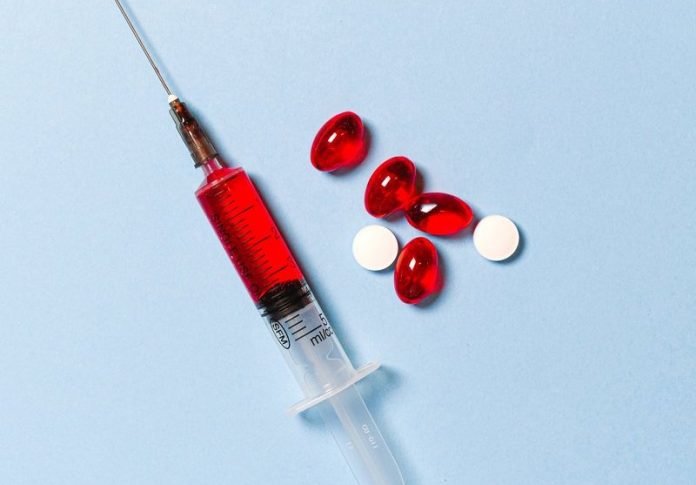
With more than 100 teams around the world racing to find a vaccine against SARS-CoV-2, including three at the University of Alberta, what are the chances of getting something that works?
The World Health Organization’s list shows 21 vaccine projects in either phase 1 or 2 of clinical trials, and two projects, one in China and the other in the U.K., in phase 3.
The top two report they are seeing protective antibodies created in their trials, but even they can’t say for sure whether, or when, their vaccines might be ready for widespread distribution.
There’s a lot at stake, with nearly 16 million of the world’s 7.5 billion people already infected and more than 600,000 dead—and the numbers are growing exponentially.
And while public health measures such as social distancing and masks seem to be keeping the lid on the pandemic in Canada, outbreaks continue now that the economy is reopening and fears are mounting about a second wave in the fall.
Folio asked the U of A’s leading experts in viruses and infectious diseases, medical ethics and drug manufacturing to map out what it will take to develop, test, manufacture and administer an effective vaccine against COVID-19.
- There is cause for cautious optimism
A typical vaccine can take a decade or more to develop, and for some diseases, such as HIV/AIDS and hepatitis C, nothing has yet been approved despite decades of work.
That said, vaccines have been developed for more than 20 life-threatening diseases, preventing millions of potential deaths each year from smallpox, diphtheria, measles and polio, among other diseases.
The pressure for success—scientific, economic, political, social and humanitarian—has never been so intense. Never before have so many scientific teams dropped everything and pivoted to study a single global problem.
Thanks to the huge international co-operative effort, enough is already understood about the immune response to the virus that it is probable a vaccine will be found to provide protection.
- More than one vaccine may work
Another reason for optimism is the number of projects underway and the variety of technological approaches being taken.
At its basic level, a vaccine’s job is to prime the immune system so it is ready to mount a powerful defence as soon as it encounters a virus. But there are many ways to do that. Each technology presents its own advantages and disadvantages.
The traditional approach is to give a small dose of weakened or inactivated pathogen, or just a part of it, so your body will recognize the real thing when it shows up.
These vaccines can take time to develop and may require large manufacturing facilities, which don’t exist in the numbers required to inoculate the world.
A newer technology involves using another harmless virus as a “vector” or delivery vehicle for a part of the COVID-19 virus, but again, this kind of vaccine may be relatively complex to manufacture and there is concern about the safety of repeated doses, which may be required to “boost” immunity.
Nucleic acid (DNA and RNA) based vaccines look promising because they are relatively cheap and easy to make, but no such vaccine has yet been approved for human use against other diseases, although many have been in development with promising results.
Concerns remain about potential changes to recipients’ chromosomes, so these vaccine options will have to pass critical safety hurdles.
- It won’t happen quickly
Much media coverage has speculated about getting a vaccine ready to go by the end of this year, but the very best-case scenario would be to have vaccines ready for widespread public inoculation of Canadians by the end of 2021.
While finding a viable vaccine candidate is challenging enough, the testing takes time and can’t be rushed, although some testing phases can be done in parallel.
Then there’s the licensing process, manufacturing and distribution of billions of doses, all of which present huge logistical challenges.
The safety and efficacy testing for a vaccine involves numerous steps, none of which can be skipped. It starts with preclinical testing in small animals such as ferrets and mice.
Then phase 1 testing evaluates whether the vaccine is safe for healthy individuals and whether it can induce an immune response.
In phase 2, you’re looking at a larger group of people to monitor safety and to see how dosage affects antibody production.
Then in phase 3 you do large-scale testing with thousands of people to see whether the vaccine really does provide protection against the virus.
How many people who are vaccinated get sick, how severe are their symptoms, are there side-effects and how well can those be managed?
While testing steps can’t be missed, there are other parts of the process that can be expedited.
For example, the U.S. government has already ordered 300 million doses of the Oxford University/AstraZeneca vaccine candidate even before phase 3 trials are complete, at a cost of up to US$1.2 billion.
- Some healthy people may have to take a risk before the rest of us get protected
The testing phases of vaccine development can’t be rushed because there is so much potential harm if things go awry.
Researchers for a dengue virus vaccine uncovered a frightening phenomenon in which some vaccinated people actually experienced more severe illness than non-vaccinated individuals when they became infected with dengue virus.
This is the exact opposite of what COVID-19 vaccine researchers hope to achieve, but the only way to find out whether their vaccines induce this response is to test them out … on a lot of people.
This summer, 30,000 healthy American volunteers will be recruited for that U.S. phase 3 trial as part of the government’s “Operation Warp Speed” on vaccine development, while 9,000 Brazilian health-care workers will be asked to try a different vaccine being developed by Sinovac. Medicago of Quebec City began phase 1 testing in 180 volunteers earlier this month, while CanSino’s vaccine candidate has been approved for human trials in Canada and is enrolling 696 people for phase 1 and 2 trials at Dalhousie University.
In all the trials announced so far, participants are given either a dose of the prospective vaccine or a placebo and then are monitored for at least two months and up to four years, depending on the phase.
The volunteers may or may not encounter the SARS-CoV-2 virus while going about their normal lives.
If the vaccine works, the people who received it would develop fewer, or at least less severe, illnesses than the control group and the general population in the region.
Meanwhile, a movement in the U.S. known as “1 Day Sooner” is promoting so-called “challenge trials,” which would purposely expose the volunteers to the active virus, effectively speeding up the time it takes to get results.
The pressure to go this route is so intense that the World Health Organization has come out with key ethics criteria for challenge trials during COVID-19.
However, the problem is that the risks of intentionally exposing healthy individuals to SARS-CoV-2 are really unknown.
With no sure, effective treatment, there is no guarantee you will fully recover if you become severely ill.
Not enough time has passed since the illness first appeared for the long-term side-effects of COVID-19—including brain, lung or kidney damage—to be fully understood.
And because you can be contagious before you even develop symptoms, you could unwittingly share the disease with family or friends who did not sign up for the trial.
- We’ll be able to manufacture the vaccines we need right here at home
It will take more than four million doses to immunize every Albertan once a successful drug or drugs are found.
Whether the winning formulae are developed in Canada or internationally, those doses for Albertans will likely be prepared at the Alberta Cell Therapy Manufacturing (ACTM) facility on the U of A campus, one of just six publicly funded Good Manufacturing Process (GMP) facilities in Canada.
- Once we have a vaccine, who will get it, and when?
The global Vaccine Alliance, Gavi, has been spearheading the conversation about what it will take to vaccinate the world against COVID-19. State governments, philanthropists and pharmaceutical companies came through with billions of dollars for vaccine research, manufacturing and distribution at a global pledging summit last month.
One of the biggest concerns is for lower-income countries that won’t be able to make or buy their own supply of vaccines.
In Canada, researchers said modelling would likely be done to determine who gets the vaccine first to ensure the most benefit for the entire population.
- You may be “strongly encouraged” to get the shot once it’s your turn
Most experts feel around 70 percent of us will need to get the shot to stop the march of COVID-19 based on the R-naught factor (R0), which is the average number of other cases caused by each infected person.
In Canada, without public health interventions in place, it is believed to be between 2.0 and 3.0.
By comparison, influenza’s R0 factor is around 1.3. The coronavirus is so much more dangerous than the flu in part because we have absolutely no background or residual immunity to the brand-new disease.
Scientists hope people can get to 70 percent of the population vaccinated without having to infringe on the liberties of those who choose not to get the shot.
- While we all wait for a vaccine, this is what you can do to protect yourself and others
Estimates suggest between five and 10 percent of Canadians have already been exposed to the SARS-CoV-2 virus.
While that number will continue to rise until a vaccine is found, it’s a long way from what’s needed to reach so-called herd immunity, which means virtually everyone is protected (at least for a while) whether they have been inoculated or not, because the disease can’t circulate through the population effectively.
While there are numerous promising antivirals and other treatments in the works, most are aimed at shortening the illness or keeping those with severe illness alive.
Until a vaccine is widely available, it’s on all of us to strictly adhere to public health practices—such as social distancing, reducing contacts, frequent handwashing, staying home when you’re sick and wearing a mask in public indoor spaces—to “keep a lid” on the virus.
It’s essential, she said, for saving lives and protecting the health-care system.
Scientists suggest keeping a log of all of the people you come into contact with on a daily basis.
The best hope to avoid another peak in cases and another potential shutdown of the economy is to watch vigilantly for localized outbreaks, then quickly trace anyone who might have been exposed, isolate them and contain the spread.
Written by Gillian Rutherford.




